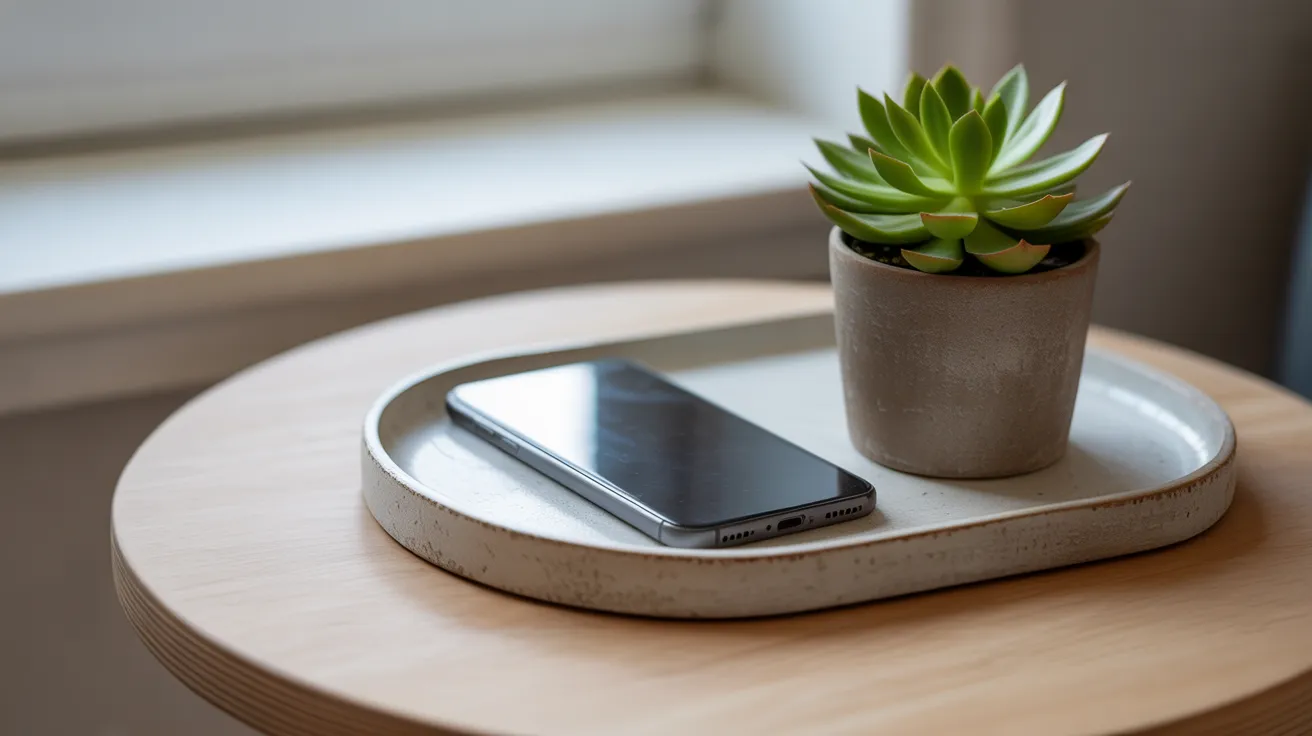
📚 Table of Contents
- 1. Understand the Attention Economy
- 2. Curate Your Digital Environment
- Set Up Intentional Focus Modes
- Practice Notification Triage and Batching
- Design a Minimalist Home Screen
- Use App Timers
- 3. Engineer Your Physical Space for Focus
- 4. Practice Mindful Tech Engagement
- 5. Implement Strategic Disconnection
- 6. Troubleshoot Common Challenges
- Handling “Relapse” Moments
- Managing FOMO (Fear of Missing Out)
- Navigating Social and Professional Expectations
- 7. Frequently Asked Questions (FAQ)
- What about my privacy when using focus apps or digital wellbeing tools?
- I work night shifts. How can I adapt these sleep tips?
- Can these strategies work for managing my children’s screen time too?
- My job requires me to be constantly connected and responsive. How can I possibly do this?
- Conclusion: Your Attention Is Your Own
Do you ever reach the end of the day feeling busy yet unproductive? You might recall scrolling through feeds, answering notifications, and switching between a dozen open tabs, but the one important task you meant to complete remains untouched. You’re not alone. This feeling of fractured attention is a hallmark of modern life in our hyper-connected, digital world.
The constant stream of information, alerts, and pings fragments our ability to concentrate. Our brains, once capable of sinking into hours of deep thought, now feel restless after just a few minutes of quiet. The ability to focus on one thing feels like a superpower we’ve lost. The cost is significant—it affects our work, our relationships, and our overall sense of well-being. We feel less present with our loved ones, less engaged in our hobbies, and perpetually behind on our goals.
But what if the solution isn’t to abandon technology altogether? For most of us, that’s simply not a realistic option. Our careers, social lives, and daily logistics are deeply intertwined with our devices. The goal, then, is not rejection but reclamation. It’s about learning how to increase attention span not by fighting against the digital world, but by building intentional, sustainable boundaries within it.
This guide offers seven practical, balanced strategies to help you reclaim your focus. We will explore the forces competing for your attention, and then provide actionable steps to build a healthier relationship with your technology. It’s time to move from a state of constant reaction to one of quiet intention, transforming your devices from masters of your attention into tools that serve your life.
1. Understand the Attention Economy
Before we can solve the problem, we must understand its roots. Your struggle to maintain focus isn’t a personal failure or a lack of willpower. You are living within a system meticulously designed to capture and monetize your most valuable resource: your attention span.
This system is often called the “attention economy.” In this economy, tech companies, app developers, and content creators compete fiercely for moments of your consciousness. The more time and attention you spend on their platforms, the more revenue they generate through advertising or data collection. To win this competition, they employ sophisticated psychological principles to make their products as compelling and habit-forming as possible.
At the heart of this is a concept known as the dopamine loop. Dopamine is a neurotransmitter in the brain associated with pleasure and reward. When you do something enjoyable, your brain releases a small amount of dopamine, which makes you want to do it again. Technology has become exceptionally good at hijacking this process. Think about the burst of satisfaction you get from a new like on a photo, a surprising email, or a funny video in your feed. These are unpredictable rewards delivered on a variable schedule—the same mechanism that makes slot machines so addictive.
Every time you pull down to refresh your social media feed, you are essentially pulling the lever on a digital slot machine. Will you get a rewarding notification? A new message? An interesting headline? The uncertainty keeps you coming back for another “pull.” This creates a powerful, often unconscious, cycle: a trigger (boredom, a notification buzz), an action (opening the app), a variable reward (the new content), and an investment (a comment or a like, which ensures you get more notifications later). This loop is what keeps you scrolling long after you intended to stop.
Understanding this is incredibly empowering. It reframes the issue from “What is wrong with me?” to “How is this system designed to affect me?” Recognizing that your phone is engineered to be irresistible is the first step toward taking back control. It allows you to approach the challenge with self-compassion and strategic thinking, rather than frustration. You can’t change the design of the entire digital world, but you can change how you choose to engage with it.
For more information on the psychological principles behind behavior and technology, the American Psychological Association (APA) is an excellent resource for research and articles. Recognizing these patterns in your own daily life is the foundational step toward dismantling them and building a more focused mind.

2. Curate Your Digital Environment
If your physical desk were covered in blinking lights, ringing bells, and tempting snacks, concentrating on your work would be nearly impossible. Your digital environment—your phone’s home screen and notification settings—is no different. To improve your focus, you must transform it from a chaotic casino into a calm, functional workspace.
The goal is to add friction to distracting activities and remove friction from productive ones. Here’s how to start curating your digital space.
Set Up Intentional Focus Modes
Modern smartphones come with powerful tools to help manage your attention. On iOS, this is called “Focus,” and on Android, it’s part of “Digital Wellbeing.” These aren’t just simple “Do Not Disturb” functions; they are customizable modes for different areas of your life. Create specific modes like “Deep Work,” “Personal Time,” “Driving,” and “Sleep.”
For your “Deep Work” mode, allow notifications only from essential work apps (like Slack or Teams from specific colleagues) and calls from a few key contacts. For “Personal Time,” you might silence all work-related apps and allow social notifications from close friends. This segmentation ensures that the alerts you receive are relevant to your current context, preventing a work email from disrupting your family dinner.
Practice Notification Triage and Batching
Most notifications are not urgent; they are interruptions disguised as importance. Go into your phone’s settings and conduct a ruthless notification audit. Turn off all non-essential alerts. This includes most social media, news apps, shopping apps, and games. Be honest with yourself: does seeing a new “like” the second it happens truly add value to your life, or does it just pull you out of what you were doing?
Once you’ve silenced the noise, implement a practice called notification batching. This is the simple act of checking your notifications at scheduled times instead of reacting to them in real-time. For example, you might decide to check your email and social media at 10 AM, 1 PM, and 4 PM. This puts you in control. You are choosing when to engage, rather than letting your device dictate the rhythm of your day.
Design a Minimalist Home Screen
Your home screen is the front door to your digital life. If it’s cluttered with distracting, colorful apps, you’re more likely to open them out of habit or boredom. Redesign it for intention. Move every app off your home screen except for essential, tool-based applications—things like your calendar, maps, notes, and camera. Apps that don’t serve a specific, immediate purpose should be moved into folders on a second or third screen, or better yet, removed from the home screen entirely and accessed only through your phone’s search function.
By forcing yourself to deliberately search for an app like Instagram or Twitter, you break the cycle of mindless, reflexive tapping. That small moment of friction is often enough to make you pause and ask, “Do I really want to open this right now?”
Use App Timers
Awareness is a powerful catalyst for change. Use your phone’s built-in digital wellness tools to set daily time limits for your most-used distracting apps. Setting a 30-minute daily limit for a social media app might feel restrictive at first, but it serves two purposes. First, it makes you acutely aware of how quickly that time is spent. Second, it creates a hard stop, preventing a five-minute check-in from turning into an hour-long scroll session. When the timer runs out, take it as your cue to move on to something more fulfilling.

3. Engineer Your Physical Space for Focus
Your ability to focus on one thing is not just a mental state; it’s heavily influenced by your physical environment. Just as you curated your digital world, you must also architect your physical world to support deep concentration and protect your downtime. This means creating clear boundaries between you and your devices.
Establish Screen-Free Zones and Times
The constant presence of a smartphone, even when face down and on silent, can diminish your cognitive capacity. Its mere presence is a lure, a subtle reminder of the vast world of information and connection it contains. To combat this, designate specific areas in your home as completely screen-free zones.
The two most impactful zones are the dining table and the bedroom. Mealtimes are opportunities for genuine human connection and mindful eating, both of which are impossible when half your attention is on a screen. The bedroom should be a sanctuary for rest and intimacy. Bringing a phone to bed not only disrupts these activities but also seriously compromises your sleep.
Prioritize Sleep-Friendly Evenings
Quality sleep is perhaps the most critical factor for a healthy attention span. Our brains consolidate memories, clear out metabolic waste, and restore cognitive function while we sleep. Screen use in the hours before bed directly sabotages this process. Devices emit high-energy visible light, often called blue light. As defined by experts, blue light exposure in the evening can suppress the production of melatonin, the hormone that signals to your body that it’s time to sleep. This can make it harder to fall asleep and reduce the quality of the sleep you get.
Create a “digital sunset” routine. At least 60 to 90 minutes before your intended bedtime, put all screens away. Use this time for calming, analog activities like reading a physical book, journaling, light stretching, or talking with a partner. For reliable information on sleep health, the Sleep Foundation provides extensive, evidence-based resources. Charging your phone overnight in another room, like the kitchen or living room, is a powerful way to enforce this boundary and ensure your first and last interactions of the day are not with a screen.
Create Cues for Deep Work
Just as you have a routine for going to bed, you can create a routine for entering a state of deep focus. Your brain thrives on cues; they act as signals that tell it what to do next. You can design a short pre-work ritual to signal that it’s time for a session of uninterrupted concentration.
This ritual can be simple. It might involve clearing your desk, getting a specific drink, closing all unnecessary browser tabs, and, most importantly, putting your phone in another room or turning it completely off. Leaving your phone in a drawer or on a shelf far from your desk is a powerful physical commitment to your task. This small act of separation creates the mental space needed to fully engage with your work, helping you learn how to increase attention span for longer periods. Over time, your brain will associate this ritual with the start of a productive period, making it easier to drop into a state of flow.

4. Practice Mindful Tech Engagement
While restructuring your digital and physical environments is crucial, the most sustainable change comes from within. It involves shifting your mindset from one of passive consumption to one of mindful, active engagement. This is about transforming your relationship with technology at a fundamental level, making every interaction a conscious choice.
Ask “Why?” Before You Engage
The most common way we lose our attention span is through mindless, habitual device use. We pick up our phones without thinking, often triggered by a moment of boredom, anxiety, or transition—waiting in line, sitting at a red light, or the moment a work task becomes difficult. The phone offers an immediate escape.
To break this habit, introduce a moment of mandatory mindfulness. Before you unlock your phone or open a new tab, pause and ask yourself a simple question: “What is my intention right now?” Are you opening your email to find a specific piece of information? Are you checking the weather? Or are you simply looking for a distraction? If you don’t have a clear, productive purpose, consider resisting the urge. This small pause can be the difference between using your device as a tool and letting it use you.
Embrace the Power of Single-Tasking
Our digital world has sold us a myth: that multitasking is a skill to be mastered. In reality, the human brain is not built for it. What we call multitasking is actually rapid context-switching—jumping quickly from one task to another. According to research from institutions like the American Psychological Association, this switching comes with a significant cognitive cost. Each time you switch, your brain has to reorient itself, which consumes time and mental energy, leading to decreased performance and increased errors.
Practice the art of single-tasking. When you are writing a report, just write the report. Close your email client, silence your phone, and resist the urge to do a “quick” search for something unrelated. When you are listening to a podcast, just listen. Don’t try to answer emails at the same time. Initially, this may feel slow or even uncomfortable, as your brain is accustomed to constant stimulation. But over time, you will find that you can complete tasks more quickly, with higher quality, and with far less mental fatigue. It is the most direct path to rebuilding your ability to focus on one thing.
Scroll with Intention
It’s unrealistic to assume you’ll never scroll through social media or news feeds again. The key is to transform this activity from a passive time-sink into an active, conscious choice. If you decide to spend time on a platform, do so with intention. Set a timer for 10 or 15 minutes before you begin. While you are scrolling, pay attention to how it makes you feel. Are you feeling inspired and connected, or are you feeling anxious, envious, or drained? This self-awareness can help you make better choices about what content to consume and when to stop. When the timer goes off, honor it. Close the app and move on with your day.

5. Implement Strategic Disconnection
The best way to appreciate the value of your attention is to experience periods of true, uninterrupted focus and rest. This requires strategically disconnecting from the digital noise. This doesn’t mean going off the grid for a week. It means building small, consistent pockets of disconnection into your daily and weekly routines. Here are two practical, worked-out examples to get you started.
Worked Example: The 10-Minute Evening Wind-Down
The goal of this routine is to create a clear buffer between your hyper-connected day and a restful night’s sleep. It’s a simple, low-effort way to reclaim your evenings and improve your sleep quality, which directly impacts your attention span the next day.
Step 1: Set a “Digital Curfew” (90 minutes before bed). Decide on a time when all screens—phone, tablet, laptop, television—are turned off. Set a recurring alarm for this time if it helps.
Step 2: Activate Do Not Disturb (DND) Mode. Before your curfew, put your phone into its most restrictive mode. DND, or Do Not Disturb, is a setting that silences all incoming calls, texts, and notifications. You can often customize it to allow calls from specific “favorite” contacts in case of a true emergency.
Step 3: Charge Your Phone Across the Room (60 minutes before bed). The single most effective habit for breaking a bedtime scrolling habit is to physically remove the phone from your reach. Plug it in to charge on the other side of your bedroom, or even better, in another room entirely. This also means you’ll have to get out of bed in the morning to turn off your alarm, which can help with waking up.
Step 4: Engage in an Analog Activity (The last 30-45 minutes). With screens out of the picture, fill the time with something calming. Read a physical book or magazine. Do some gentle stretching. Write in a journal. Tidy up your space for the next day. Listen to calm music or a podcast on a smart speaker without a screen. This analog transition tells your brain it’s time to power down.
Worked Example: A Realistic “Low-Fi” Weekend
The purpose of a low-fi weekend is not to eliminate technology but to reduce your reliance on it for entertainment and distraction, allowing for more presence and rejuvenation. It’s a digital detox without the complete isolation.
Saturday Morning: Create an Analog Start. Vow to not check your phone for the first hour of your day. Leave it on DND or in another room. Make coffee, go for a walk, read the newspaper, have a conversation with your partner or family. Start your weekend with an activity that grounds you in the physical world.
Saturday Afternoon: Use Tech as a Tool, Not a Toy. For the bulk of the day, treat your phone like a single-purpose tool. Need directions? Use the map and then put it away. Need to coordinate with a friend? Call them instead of getting into a long text exchange. The key is to delete, log out of, or use app timers to block your most distracting apps (social media, news, email) for the day. This prevents you from falling into a scroll hole when you only meant to check the time.
Sunday: Schedule Your Re-entry. Total avoidance can sometimes create a “rebound” effect where you binge on Monday. Instead, schedule a specific time on Sunday evening—say, from 5 PM to 6 PM—to consciously catch up. Respond to important messages, check your calendar for the week ahead, and briefly scan anything you missed. By time-boxing this activity, you re-engage on your own terms and prevent the “Sunday scaries” that often come from a flood of notifications and emails right before bed.

6. Troubleshoot Common Challenges
Reclaiming your attention span is a practice, not a one-time fix. You will inevitably encounter setbacks and challenges. Anticipating these hurdles and having a plan for them is key to long-term success. The goal is progress, not perfection.
Handling “Relapse” Moments
There will be nights when you find yourself scrolling until midnight, or days when you get completely lost in a rabbit hole of open tabs. It happens. The most important thing is how you react. Do not view these moments as failures. Instead, treat them as data. Get curious, not critical.
Ask yourself: What triggered this? Was I feeling stressed, bored, lonely, or anxious? Was I trying to avoid a difficult task? Understanding the underlying emotion or situation that leads you to seek digital distraction is crucial. Once you identify the trigger, you can come up with an alternative, non-digital coping strategy for the next time it arises. Maybe a five-minute walk, a quick conversation with a colleague, or a few deep breaths can serve the same purpose as an hour of mindless scrolling.
Managing FOMO (Fear of Missing Out)
A major reason we stay glued to our devices is the fear of missing out on a crucial piece of news, a social event, or an important cultural moment. Social media platforms are designed to amplify this feeling. The endless scroll promises that the next post could be the one you can’t miss.
To counter FOMO, you can actively cultivate JOMO: the Joy of Missing Out. JOMO is the satisfying feeling of being disconnected and fully present in your own life. It’s the joy of having an uninterrupted dinner, reading a book without your phone buzzing, or going for a hike and focusing on nature instead of capturing the perfect photo. Remind yourself that the vast majority of what happens online is not essential to your well-being. Curate your feeds to be less about what everyone else is doing and more about your own interests and inspirations. Unfollow accounts that consistently make you feel anxious or inadequate.
Navigating Social and Professional Expectations
In our always-on culture, there can be a real pressure to be constantly available. Friends might expect instant text replies, and colleagues might send emails late into the evening. Setting boundaries can feel uncomfortable at first, as if you are letting people down.
The solution is clear, proactive communication. You don’t need to make a grand announcement, but you can manage expectations in small ways. Add a line to your email signature like, “I check email twice a day to maintain focus. Thank you for your patience.” Let your friends and family know, “I’m trying to be on my phone less, so if you don’t hear back from me right away, that’s why. Call me if it’s urgent.” Most people are understanding, and you might even inspire them to adopt similar habits. You are teaching others how to interact with you in a way that respects your time and attention.

7. Frequently Asked Questions (FAQ)
As you begin to implement these strategies, some practical questions may arise. Here are answers to some of the most common queries about reclaiming focus in a digital world.
What about my privacy when using focus apps or digital wellbeing tools?
This is a valid concern. The good news is that the tools built directly into your phone’s operating system (like Apple’s Screen Time and Google’s Digital Wellbeing) are generally very secure. The data they collect about your usage typically stays on your device and is not shared with the company for advertising purposes. However, if you choose to download third-party focus or productivity apps, it’s essential to be a discerning consumer. Read their privacy policies, check what permissions they require, and favor apps from reputable developers that are transparent about how they handle your data.
I work night shifts. How can I adapt these sleep tips?
The principles of good sleep hygiene are universal, even if your schedule is not. The key is consistency. Your “digital sunset” should occur 60-90 minutes before your designated sleep time, whether that’s 10 PM or 10 AM. The goal is to create a dark, quiet, and cool environment. Invest in high-quality blackout curtains and a white noise machine to block out daytime light and sound. Most importantly, treat your daytime sleep period as sacred. Use your phone’s DND mode and communicate your sleep schedule to friends and family so they know not to disturb you.
Can these strategies work for managing my children’s screen time too?
Absolutely. The core principles of intentionality, environmental design, and creating boundaries are the foundation of healthy family tech habits. Establishing screen-free zones like the dinner table and bedrooms is even more critical for children. The most powerful tool, however, is your own behavior. Modeling a balanced relationship with your devices—putting your phone away when you’re talking to your kids, engaging in analog hobbies, and setting clear boundaries for yourself—is more effective than any parental control app. You can find valuable research on child development and media use from organizations like the National Institutes of Health (NIH).
My job requires me to be constantly connected and responsive. How can I possibly do this?
This is a common challenge in many modern professions. The goal in this situation is not total disconnection, but strategic control. You must find the pockets of autonomy within your day. First, ruthlessly curate your work-related notifications. Do you really need a pop-up for every single email? Or can you use notification batching and check your inbox at the top of every hour? Second, block out “deep work” sessions in your shared calendar. This signals to your colleagues that you are unavailable for a set period. Third, communicate your workflow. Let your team know that you’ll be offline after a certain hour but will respond first thing in the morning. Even an hour or two of focused, uninterrupted work can be more productive than a full day of constant distraction.
Disclaimer: The information provided in this article is for educational and informational purposes only and is not intended as a substitute for professional medical or psychological advice, diagnosis, or treatment. Always seek the advice of your physician or other qualified health provider with any questions you may have regarding a medical condition.
Conclusion: Your Attention Is Your Own
Reclaiming your attention span in a noisy digital world is an ongoing practice, not a destination. It’s a journey of making small, conscious choices every single day that, over time, compound into a more focused, present, and fulfilling life. You don’t need to throw your smartphone away or delete all your accounts. You simply need to shift your posture from one of passive reaction to one of mindful intention.
The power to focus on one thing, to be truly present with your work, your family, and yourself, is not lost. It’s just buried under a pile of notifications, infinite scrolls, and unread emails. By intentionally curating your digital and physical environments, practicing mindful engagement, and troubleshooting challenges with compassion, you can begin to dig it out.
Start small this week. Don’t try to do everything at once. Pick one or two of these simple changes to implement:
First, turn off all notifications for one app that you know distracts you the most.
Second, move that same app off of your home screen, forcing you to search for it when you want to use it.
Third, designate one meal each day—lunch, dinner, your morning coffee—as a completely screen-free time.
Finally, tonight, charge your phone somewhere other than your bedside table.
These small acts are the first steps toward taking back control. They are a declaration that your attention is your most valuable asset, and it is yours to direct.






